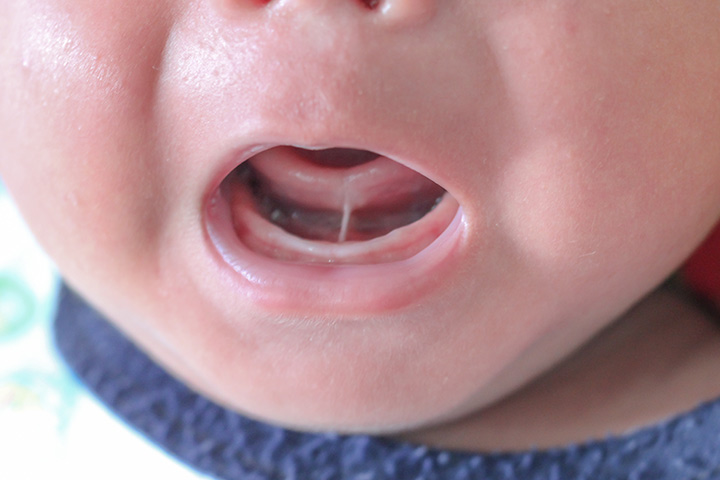
You may have heard of the expression “tongue-tied” before; in fact, you may have been in a situation where you were tongue-tied outright. The expression itself means simply to be at a loss for words, either from surprise, confusion, or nervousness. If you are tongue-tied you will probably have difficulty saying what you want to say. But as it turns out, the expression did not simply come into being from widespread usage; the use of the term ‘tongue-tied’ in a figurative sense actually came from being tongue-tied in a literal sense. This condition is known as ankyloglossia.
Ankyloglossia is a congenital condition in which the lingual frenulum, the stretchy membrane that connects the tongue to the bottom of the mouth, is shorter than normal. This results in the tongue not being able to move as freely as it normally would. The condition is not uncommon, occurring in around 4 to 11 percent of all newborn babies each year, can appear in varying degrees of severity and less than half will experience feeding problems. It is advisable to speak with your local tongue tie expert in Newcastle in order to get the necessary and correct advise.
The rarest and most severe cases, also called complete ankyloglossia, will permanently anchor the tongue to the floor of the mouth. Milder cases, meanwhile, do not have similarly adverse effects, although they will still cause some issues. For example, infants with ankyloglossia may have some trouble with breastfeeding due to a poor latch. In an older child, the limited mobility of the tongue can make it difficult for the child to swallow or eat solid food. The tethering of the tongue to the bottom of the mouth can make cleaning the back of the teeth in the lower jaw more difficult and impair the child’s for general oral hygiene. The child may also have trouble vocalising certain sounds like the ‘l’ or ‘th’ sounds because the tongue tie prevents the tongue from hitting the palate or roof of the mouth, causing problems with speech development that can lead to further problems in social contexts.
If your child has been found to have a tongue tie, doctors will have conflicting opinions on the best treatment. Some doctors may recommend that you don’t do anything about the tongue tie for the time being. The reasoning behind this is that both the tongue and the frenulum will grow over time as the child ages, and it is possible for the frenulum to stretch out at some point, resolving the tongue tie issue without you needing to intervene. Other doctors will point out that this does not happen 100% of the time; if this is the case or if the tongue tie causes major issues for the child, your doctor will recommend surgical intervention.
There are two common procedures for this. The first of these is called frenotomy (also called frenulectomy), and involves holding the tongue up to expose the frenulum, and then cutting it with sterile scissors. Laser frenotomy has become popular without proven benefit and may result in increased costs. The procedure is very quick and will not take longer than a few seconds; as such, doctors often do not use anaesthesia for young babies. There are also few complications associated with the procedure, although in rare cases bleeding may occur, which is usually caused by an underlying problem. Frenotomy is usually done on newborns who are found with a tongue tie – in which case the doctor may offer to have the tongue tie immediately after birth – or on older infants who have difficulty breastfeeding.
For older infants or children who are unlikely to tolerate quick snip in the office a frenuloplasty under day surgery general anaesthsia is offered. This is a more extensive minor surgical procedure that will completely remove the tongue tie. Although frenuloplasty is not as short a procedure as frenotomy due to the safety precautions that need to be taken, frenuloplasty does not take too long either, with the child ready to be discharged from the hospital within the same day of the procedure.
Like all surgeries, the patient must undergo a preparatory phase before anything else. In this case, the child must not eat any food for at least 6 hours prior to the surgery. Clear fluids are permitted up until 2 hours prior to the surgery. You as the parent or guardian should naturally guide them through the process and alleviate any concerns. We recommend that you bring their favourite toy along to keep them occupied while you wait. During this time you will also meet with the anaesthetist, who will examine your child before heading on to the operating room. One parent can come into the operating room with the child to help them calm down. The child will be placed under general anaesthesia by face mask or by injection and the parent then leaves the room. The surgical procedure itself normally takes 15 minutes. As soon as the child emerges from the anaesthetic the parent is called to be with them in the recovery room.
After the operation, the child should be given Paracetamol (acetaminophen) in the afternoon and night of the same day, as well as in the morning of the same day. If the child still experiences pain after the surgery, consult your doctor so they can prescribe a stronger medication. The child may begin eating as soon as food is desired but they should start first with liquids and take soft food for 2-3 days after the procedure. A follow-up appointment is advised 4-6 weeks after the surgery or earlier if any concerns.
The frenuloplasty should not have any major side effects besides some scarring of the wound, as well as the child experiencing some side effects as a result of the anaesthesia. If the child experiences a fever, excessive pain in the wound area, or you see any signs of infection on the wound, contact your doctor or emergency services immediately.
